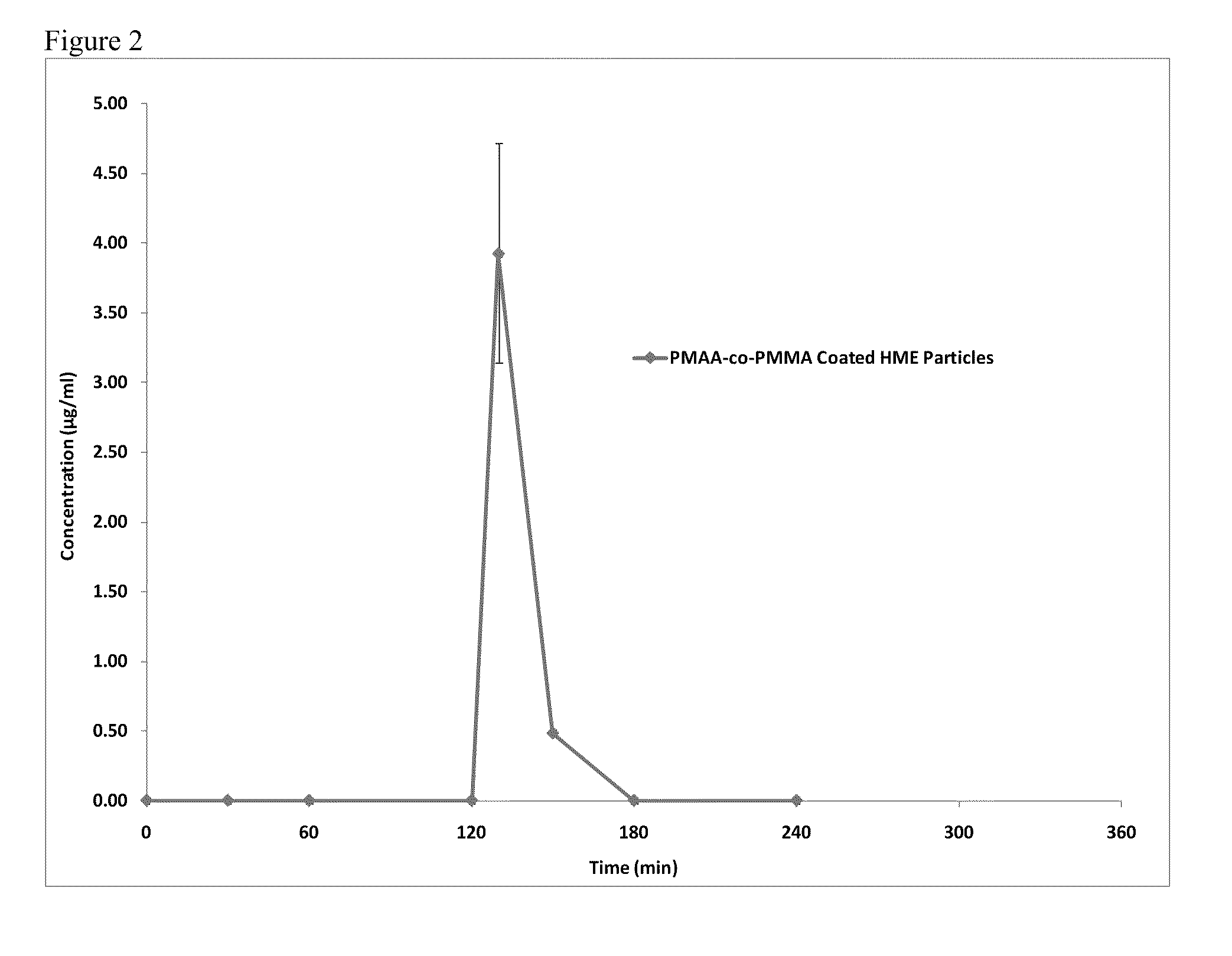Encapsulated particles for enteric release
a technology of enteric release and encapsulation particles, which is applied in the field of encapsulation of materials, can solve the problems of low product yield, poor stability of encapsulated products, and low product yield, and achieve the effect of eliminating the chance of incorporation of undesirable compounds and easy coating
- Summary
- Abstract
- Description
- Claims
- Application Information
AI Technical Summary
Benefits of technology
Problems solved by technology
Method used
Image
Examples
example 1
Amorphous Itraconazole Particles with PMAA-co-PMMA Coating
[0131]For this study a plasma enhanced chemical vapor deposition process was employed using both methacrylic acid (MAA) and methyl methacrylate (MMA) monomers to deposit a thin coating layer on the surface of an amorphous Itraconazole (ITZ) drug particle. The amorphous ITZ drug particles were prepared using a process known as hot melt extrusion (HME) and were prepared from a pre-extrusion blend of crystalline ITZ and Eudragit L100-55 excipient (1:2). The final potency of the as prepared HME amorphous particles was 28.73% (SD of 0.09%) as measured by high pressure liquid chromatography (HPLC). The coating layer was deposited using a variable duty cycle and variable power 13.56 MHz plasma enhanced chemical vapor deposition coating process. During the first stage of the coating process a peak power of 15 watts and a duty cycle of 5 ms on and 30 ms off was utilized for 60 minutes at a constant reactor pressure of 100 mTorr. After...
example 2
Amorphous Itraconazole Particles with Perfluorohexane Coating
[0135]A plasma enhanced chemical vapor deposition process was employed using perfluorohexane (C6F14) monomer to deposit a thin coating layer on the surface of an amorphous ITZ drug particle. The amorphous ITZ drug particles were prepared using a process known as HME and were prepared from a pre-extrusion blend of crystalline ITZ and Eudragit L100-55 excipient (1:2). The final potency of the as prepared HME amorphous particles was 28.73% (SD of 0.09%) as measured by HPLC. The coating layer was deposited using a 13.56 MHz plasma with a peak power of 150 watts and a duty cycle of 10 ms on and 40 ms off. The reaction chamber was maintained at a pressure of 160 mTorr with a monomer flow rate of 100 sccm for 75 minutes. After coating the amorphous HME particles were tested using differential scanning calorimetry and showed no recrystallization occurred during the coating process. The potency of the particles after coating was al...
example 3
Crystalline Itraconazole Particles with PMAA-co-PMMA Coating
[0138]A plasma enhanced chemical vapor deposition process was employed using both MAA and MMA monomers to deposit a thin coating on the surface of a crystalline ITZ drug particle. The crystalline ITZ particles (BP micronized) were purchased from Hawkins, Inc. and used as received. The coating was deposited using a 13.56 MHz plasma with a peak power of 16 watts and a duty cycle of 0.5 ms on and 30 ms off. The reaction chamber was maintained at a pressure of 100 mTorr and the monomer flow rates of MAA and MMA were maintained independently at 75 and 25 sccm, respectively. After coating the ITZ particles were examined using differential scanning calorimetry which confirmed the presence of crystalline drug material. The potency of the ITZ particles after coating was also tested and was measured to be 99.87% (SD of 0.21%).
[0139]FIG. 5 shows the dissolution testing results for the PMAA-co-PMMA coated crystalline Itraconazole ITZ p...
PUM
 Login to View More
Login to View More Abstract
Description
Claims
Application Information
 Login to View More
Login to View More - R&D
- Intellectual Property
- Life Sciences
- Materials
- Tech Scout
- Unparalleled Data Quality
- Higher Quality Content
- 60% Fewer Hallucinations
Browse by: Latest US Patents, China's latest patents, Technical Efficacy Thesaurus, Application Domain, Technology Topic, Popular Technical Reports.
© 2025 PatSnap. All rights reserved.Legal|Privacy policy|Modern Slavery Act Transparency Statement|Sitemap|About US| Contact US: help@patsnap.com



